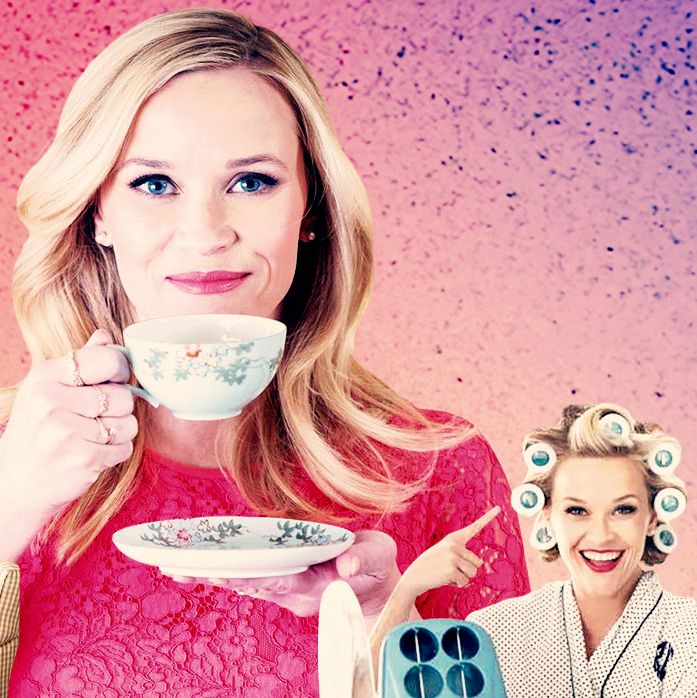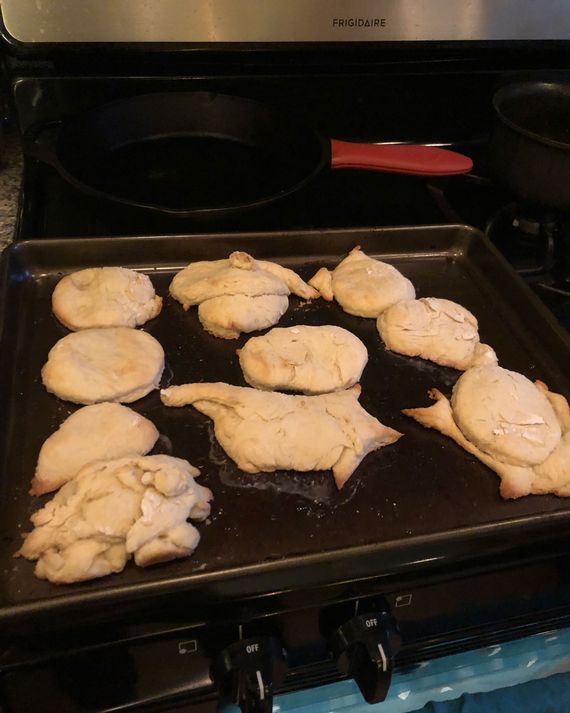
Reese Witherspoon has always terrified me, and I mean that entirely as a compliment. She’s read basically every single book that’s been published in the new millennium, options 78 percent of them, produces 400 TV shows and movies per year, stars in about half of those, is raising three children to adulthood, runs a clothing line, and also finds time to teach Natalie Portman how to do Instagram. Her “73 Questions” interview is exhilarating; at one point, she effortlessly does a backflip. Once, I read somewhere that Reese runs two miles every single day. She also seems very frightening to cross, especially while on one of those runs. In other words, Reese Witherspoon clearly does not sleep, both literally or on anything. As someone who requires 11 hours of sleep a night and has never once scolded a paparazzo while wearing gym shorts, my mind is incapable of fully grasping the concept of Reese Witherspoon.
Recently, Reese has done yet another improbably time-consuming thing: written a lifestyle book. Called Whiskey in a Teacup: What Growing Up in the South Taught Me About Life, Love, and Baking Biscuits, it’s part memoir, part instructional guide, cheerfully detailing the sorts of homemaking activities that would take up most people’s entire lives. As Reese puts it, “You’ll learn how I keep my home, how I entertain, and just how much fried food I eat. And you’ll see how easy it is for you to bring a little bit of the South home, no matter where you live. After all, there’s a southern side of everywhere in the world, right?” Right.
Over the course of nearly 300 glossy pages, Reese writes a paean to both growing up in the South and the joys of re-creating the South wherever you go — to achieving what her late grandmother Dorothea called “a combination of beauty and strength that made Southern women ‘whiskey in a teacup.’” Reese’s instructions for achieving said combination include, but are not limited to, dozens of recipes, hairstyle tutorials, multiple party-hosting guides, “Southern conversation-starters,” an ode to quilts, a page called “flea market strategies,” a chapter on why you should monogram everything you own, an essay about how to have a wedding correctly, a chapter on wallpaper, a piece about why baby showers are very fun, and a tribute to the singular delights of horse-themed dinnerware.
As a midwesterner whose own grandmother once crowed, “Those are really some ‘throw me down and fuck me’ shoes!” at her lunchtime bat mitzvah, Reese’s refined Southern childhood could not have been further from mine. As a grown woman whose idea of “entertaining guests” is putting on a bra the minute the doorbell rings, reading Reese’s handbook for adulthood felt like a light, but not unwelcome, slap in the face.
When my editor asked me to attempt to live by Reese’s book for a full week, I felt both dark horror and masochistic excitement. Could I, a woman who collapses into the street every time she wears heels, manage to even partially mimic the Reese Witherspoon lifestyle? Could I become, as Reese wrote, one of the women who “always looked elegant and put together and were quick with a warm smile, but who were also the undisputed bosses at their places of business and in their homes”? Could I, a woman who once poisoned herself making scrambled eggs, become a shiksa goddess effortlessly cooking a ham on Christmas while simultaneously hot-rolling her hair and monogramming her towels? More importantly: Could anyone???
Day 1: A Very Reese Christmas
Because Reese manages to do all of the things she writes about in her book while also tightly gripping HBO by the balls, I decide to pick one or two Reese-y activities per day and try to accomplish them while also doing things I would normally do. My Sunday itinerary is often “read in the bathtub for 14 hours,” so it seemed like a good day to start.
My first order of business: Throw a Reese Witherspoon–style Christmas party. Reese has several party-themed chapters in her book, including: a Full Moon BBQ, a Kentucky Derby Party, a Book Club Party, a Steeplechase Picnic, a Summer Porch Picnic, and a chapter about her various holiday traditions entitled “Why Southern Ladies Love Holidays.” “Most ladies I know decorate for every season of the year, and some even switch out their china,” writes Reese. “Here’s how my party goes: We have a yummy dinner of ham and biscuits, always. Just ham and biscuits. Once everyone’s had some ham and biscuits, and some drinks, we gather around the piano and start singing carols.”
It should go without saying that I own ten plates total, all of which my parents used for 20 years and all of which have chips in their porcelain that will eventually harm someone. It absolutely needs to be said that I’ve never once used my oven, yet live in perpetual fear that I forgot to turn off my oven. It also needs to be said that the Sunday I have selected is, incidentally, the first day of Hanukkah; cooking a ham on Hanukkah is probably enough to get me into the Jewish hell that they CLAIM does not exist. But like the Maccabees, I bravely trudge forward.
In an entirely separate chapter, Reese has a sidebar detailing “Dorothea’s Seven Hostess Tips.” Reese and Dorothea tell me I must send invites to “people of different ages and backgrounds to make the conversation more interesting” at least two weeks in advance. Fortunately, I have already sent a text the week before inviting my deeply confused friends — all of whom are the exact same age but were born in various states — over for “ham and biscuits.” I’m also informed that I must do as much prep as possible beforehand, decorate with fresh flowers and unscented candles, put out napkins with “clever sayings,” have a fully stocked bar and keep everyone’s glasses full the entire night, serve dinner one hour after the start time, and “play Louis Prima or Ella Fitzgerald.”
My biggest struggle turns out to be the “napkins with clever sayings” (Reese suggests “Wine, because kids” as an example). I can only find New Year’s themed napkins that say “Four, Three, Two, One” at the dollar store, and I can’t buy them because there’s a $10 credit-card minimum. I light my most Christmassy scented candle, because unscented candles are cops, and I purchase poinsettias for the first time in my life, which one of my party guests later tells me are poisonous to dogs (while holding her dog).
One hour before my guests are due to arrive, I begin to cook my ham. I am wearing boxer shorts and lipstick because Reese places an extremely high value on wearing lipstick at all times (“I am obsessed with lipstick … putting it on makes me feel ready for the day and ready for the world”). Earlier, I’d heard rumors from Ham Twitter that all ham comes previously cooked, but I can’t tell if that applies to my particular ham. I call my parents, asking for ham-cooking tips. “Ham? How goyishe,” says my dad helpfully.
Reese wants me to glaze my ham with one thousand ingredients, then cook it for several hours. Immediately, I realize I am missing nearly all of these ingredients. I end up mad-scientist-ing a glaze of orange juice, syrup, cinnamon, and watery mustard; it foams violently, hardens almost immediately, and nearly destroys my stove top. My boyfriend, Adam, who usually cooks for the both of us and whom I have instructed not to help me at all, frantically scrapes at it for the next 15 minutes.
Simultaneously, I am making biscuits. I realize I have neither a biscuit cutter nor a mixer; trapped inside a mushroom cloud of flour, I use a whiskey glass to cut the biscuits into the “right shape.” Did I mention I’m also drinking? Reese did insist upon a full bar (which I absolutely do not have), so technically this is part of my assignment.
My friends arrive just as the biscuits are coming out of the oven. The biscuits look like they barely survived Chernobyl, but stunningly, they are delicious. The reviews come pouring in. “This tastes great,” says my friend Dan. “The only problem with it is the shape and size.” Adam nods: “It’s definitely a biscuit.” My friend Sarah praises its “whimsical shape”; Alexandra describes the biscuit as “catlike.” Jon agrees that the biscuits are “perfect if you just close your eyes.”
I fill my friends’ glasses every 14 minutes, nearly killing us all. In the meantime, I test my ham intermittently with my meat thermometer; every single reading is wildly different. At a completely arbitrary point, I decide it’s ready and reveal it to the room. Everyone is visibly frightened of it. I take the first bite; it tastes salty, sweet, and a little scary, just like me, the perfect Christmas-party hostess. Slowly, my friends begin to eat it, and everyone agrees: It is a great ham.
Here are some real, on-the-record ham reviews, from people who had one to five wines:
—“A nice thick cut.”
—“Smells like ham to me.”
—“It feels like I’m at Old Country Buffet.”
—“Wow … I’m pretty into this ham.”
—“This is a really fucking good ham.”
—“I want to stop eating this ham, but I can’t.”
Cleaning up after the party, I realize the meat thermometer never had batteries in it.
Day 2: The Magic of Sweet Tea
The only thing Reese Witherspoon loves more than ham and biscuits is sweet tea, which gets an entire chapter in Whiskey in a Teacup. According to Reese, people in the South love to “drop by” unannounced, and you should have sweet tea on hand for when they do. Even though every TV show about living in New York City makes it seem like New Yorkers also love to drop by unannounced, this never happens to me.
Again, despite preparing for this task, I find myself ill-prepared. I’m supposed to place eight black tea bags in a gallon-size Mason jar, but I accidentally bought green tea, and also, please show me somebody with a New York apartment that also owns a gallon-size anything. I shove six green tea bags into a normal-size Mason jar I once stole from a college bar (I’m sorry Dorothea!), then put it in the only available “sunny spot” — my window, on a cold and cloudy December morning — for an entire day while I’m at work.
I’m supposed to prepare a “simple” syrup while the tea brews, but I have to go to work, plus I am still working on getting the other glaze-syrup off of my stovetop. I will not be tricked by syrups again.
When I come home that night, I realize I’ve just made a very complicated iced green tea. Struck with sudden inspiration from my previous evening of ham-glazing, and completely forgetting my new syrup rule, I pour a big gush of maple syrup into it. It is fucking delicious! Reese, you maniacal genius! I drink it by myself, directly from the jar, all week and do not give it to any friends who come over.
Day 3: Hot Rollers and Steel Magnolias
“Presenting yourself well is a way to show others you care about them,” says Reese. This is why, she explains, I must never wear sweatpants on an airplane, or jeans to the theater, or ride a horse without riding boots. It is also why I must learn to hot-roll my hair.
By way of background: A few years ago, I ran into a college acquaintance at a wedding. She reached out and touched my head. “You finally figured out how to do your hair!” she said brightly.
Reese dedicates five full pages (with photos) to this particular art. She explains that, in order to do it correctly, I’ll need to mousse my hair, roll it up in six to eight rollers, get in the car, drive somewhere, and then brush my curls out when I arrive. I own neither a car nor hot rollers. The latter I purchase at Ricky’s.
First thing in the morning, I plug in the rollers, mousse up, apply bright-red lipstick while I wait, then roll one into my hair. I realize instantly that I have no way of keeping the hot roller suspended against my head — Reese refers vaguely in her chapter to “clips,” as do the Conair hot-roller instructions, but there are no clips to be found in the actual hot-rolling kit. I try to clip it in with a hairpin, which doesn’t work; eventually, I manage to balance it precariously against my ear for a few minutes.
When I roll it down, my hair looks fucking insane.
Suddenly, I remember I have a long-scheduled doctor’s appointment this morning with a new internist, and race across town with my maniac hair and smeared lipstick. I nearly explain my appearance to her, then realize that Reese would never explain herself to anyone, much less a medical professional. The doctor says absolutely nothing about any of it, which I take as a general indictment of my character.
Later, per Reese’s instructions, I watch and rewatch the Steel Magnolias beauty-parlor scene, which she devotes a column to smack in the middle of her hot-rolling lesson. “Take acting classes if you can,” she says, “but if not, just watch that one scene over and over. Study it well, and I guarantee it will improve your craft.” It’s true; I am now an expert in faking diabetic shock. When Reese invites me to a party, I will show her.
Day 4: Pregaming a Gala (and Hot Rolling)
On my way to work, I stop at Ricky’s again to purchase the aforementioned “clips.” The woman I buy them from agrees that it is borderline illegal that the hot-rolling kit does not include clips, despite specifically referring directly to said clips.
After work, I race home, because today is the day that I am Pregaming a gala. Reese writes that when she was a kid, her parents went to a lot of fancy parties, but first would have friends over for drinks and hors d’oeuvres. “I always longed to go out with them, but I was too young, so my brother, John, and I would stay home playing Boggle and eating all the leftover snacks,” she says. Now Reese pregames her own galas. She and I agree that adulthood is all about gentle fuck-yous like this.
Reese wants me to make “Confetti Betty’s Champagne and Ginger Ale Cocktail,” smoked pecans, and crab puffs. I immediately veto the crab puffs because I know if I attempt seafood, I will put myself in the hospital.
The cocktail is named after Reese’s mom, who is referred to as “Confetti Betty,” not due to all of her raucous partying, but because she recently learned how to use the animated confetti effect in iMessage. Betty is far ahead of me on the technology front, but the cocktail is the easiest thing Reese wants me to do: Champagne, ginger ale, and little ginger candies, which I bought earlier in the week.
The cocktail is … fine. I drink several and nearly break a tooth on the candy. I decide I should not hot-roll my hair in this state, but I do dress up and even put on glittery eye shadow, which later gives me a light skin reaction.
The smoked pecans are a little more complex: I’m supposed to halve four cups of pecans, mix them with liquid smoke and water and salt and smoked paprika (I don’t know her), let them sit for an hour, then bake them for 20 minutes. However, my “gala” (a press screening of Mary Queen of Scots) is beginning in an hour, so I just pour a deluge of liquid smoke and water and salt on the full-size pecans, mix it all around very aggressively, and shove it in the oven.
Twenty minutes later, I am tipsy in the back of a Via, having eaten hundreds of pecans that tasted like they were scorched in the fires of hell. In the middle of Mary’s rebellion, I develop a violent stomach ache. When I get home, my apartment smells like 100 arsonists had an orgy.
Day 5: “Selling” Lemonade (… and Hot Rolling)
In a chapter entitled “Catching Frogs and Selling Lemonade,” Reese writes about how her grandmother and mother helped shape her southern manners (“the only place to chew gum is behind a door”) and her business acumen. “Southern women are strong and outspoken but also beautifully composed and always present their best selves to the world,” she says. Even as a young, beautifully composed girl who chewed gum in complete silence, she would “harangue” people to buy things from her, like lemonade, and — WOW — HAIR CLIPS (!!!). MUST BE NICE.
“I think a lemonade stand is a really good way for kids to learn about business,” she says. “My brother and I took it very seriously.”
As a kid in the cosmic sense when it comes to “business,” I decide I should probably hold my own lemonade stand. I briefly consider holding it outside of my East Village apartment, but realize I will immediately be arrested for selling drugs or peed on. Instead, I decide I will make the lemonade, bring it to work, and charge my co-workers to drink it.
My morning is supposed to be spent calmly making this scam lemonade. But instead, I waste it trying to hot-roll my goddamn head. The new clips are too small to keep my hair against my head, and I spend 30 minutes trying to use various household objects (forks, syrup) instead. Here are the notes I wrote to myself about my third attempt at hot-rolling:
Hot rollers, even with clips, are true bullshit.
They do not stay up!!!
Clips won’t go into the little slots they say not to use.
Very angry.
Day 6: Selling Lemonade … Again
I wake up even earlier today to make sure I have time to do my hair, make lemonade, and keep my job.
The lemonade turns out to be more time-intensive than I anticipated: Reese has me out here juicing 12 lemons and making ANOTHER simple syrup. She also wants me to put the lemonade inside of a gallon jar, which, again, why would I ever own something so crazy?
I juice the lemons into a yellow bowl and am struck by a strong urge to drink the lemon juice plain. I take a few laps around the apartment to come back to myself. The syrup, which is essentially grated lemon zest and sugar heated up, is equally tempting. Mixed together, the lemonade is incredible: sweet, a little savory, refreshing, beautifully composed. It makes me want to put on riding boots and ride a horse to an empty field, where I will burn all of my sweatpants and jeans and gum.
I drink half of it directly from the bowl, then realize I have neither a way to transport it to work, nor the inclination to give it to anyone else. This is MY lemonade. I understand business perfectly now.
At the last minute, I decide to take the day off from hot-rolling as a gift to myself for being such a good businesswoman.
Day 7: I Don’t Even Know
All of my plans for the week have been laid to waste. At one point I was supposed to monogram something — anything — and I had plans to “Do Good,” which is the name of the last chapter in Reese’s book. Unfortunately, I have been waylaid by ham, hot rollers, and “business.”
Today, I will finish what I started. I head to CVS and buy the most gigantic hair clips I can find — the ones that Rachel Weisz and Natalie Portman wear in movies where they play “intellectuals.” I get out the hot rollers once more, attack my head with the clips, and wait.
Even though I have done everything 100 percent correctly, my hair looks 100 percent incorrect: Half curly, half straight, and in some places, angled at a perfect 90 degrees. If Reese encountered me with this hair while on a run, she would berate me like the reckless paparazzo I am.
I storm (gracefully, elegantly) back to Ricky’s to return the hot rollers. The same woman is there, and we agree that this is both the fault of Conair and the fault of late capitalism, which would have me purchase a product that requires another product to work.
Back home, I’m calmer, knowing the hot rollers will not haunt me anymore. I have one thing left to focus on: my business.
My cousin Amy, who lives in the South and is therefore an expert on all of this, is visiting New York. I invite her to my apartment to sell her my lemonade. I inform her that it will cost ten cents per glass. “I like that you’re serving it directly from a bowl and still charging me,” she says. She and Adam sip it in frightened silence.
Both look at each other in surprise. “It tastes very southern,” says Amy. “There’s a richness to it — a depth,” says Adam. “I feel like I could be on a front porch in an Adirondack chair.” Both try to do an imitation of a southerner on a porch drinking lemonade, but Adam sounds British.
Suddenly, I realize there’s one very important thing I haven’t done. I grab a bottle of Bulleit from my bar cart and pour it directly into the lemonade. I dunk everyone’s glasses directly into the bowl, and serve the new concoction to my guests, whom I did not invite two weeks in advance, and whom I did not give napkins with clever sayings, but who have been known to wear jeans to the theater. “It’s time,” I say dramatically, “to drink whiskey in a teacup.” (I do not own teacups.)
Drinking lemonade and alcohol directly from a bowl in the middle of winter with terrible hair is not necessarily where Reese would want me to be, but it’s where she might stumble upon me and say, “Okay, honey, you tried.” It occurs to me that maybe Reese wrote her book for people like me — people who would try to live by it, do a mediocre job, and then fall back into the total, soothing, but now slightly more southern chaos of their own lives. Maybe Reese wanted me to reach for the stars, because even if I fell, I would land in a bowl of whiskey lemonade, surrounded by oversmoked pecans. Maybe Reese wanted me to know: I will never do a backflip on my home trampoline, but I am beautifully composed. I am showing the people I love that I love them by wearing lipstick and giving them freaky biscuits. I am a businesswoman who made 20 cents on her business (Amy, please pay me). I am a ham-maker. I am Confetti Betty. I am Julia Roberts in Steel Magnolias, minus the death.








